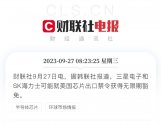Influential US think-tankies are now proposing to get China addicted to foreign high-end chips, just not the requisite equipment to manufacture at home. (source:
)
In other words, Restore pre-2019 Chinese access to Western high-end chips, while maintain post-Oct 2022 American ban on chip-making equipment to China... and since Western chips have lower price and higher quality, it would keep Chinese OPPO and Vivo dependent and domestics few generations back.
Memory prices have been falling due to excess supply and dramatic drop in demand. Excess supply will pressure YMTC pressured to lower memory prices and struggle to gain market share. Samsung and SK Hynix is least bad because it's at least mainland fabs employing mainlanders...but still, subject to the ebbs and flows of US elections which could change at any time.
Yes, agreed 100%. There should be a soft mandate on YMTC utilization by domestics, otherwise YMTC will struggle on market share. All it takes is one sitting U.S. President to change the unlimited exemption waivers back to one year again, and guess who is leading Republican primary polls... "
Fool me once, shame on you ..... Fool me — you can't get fooled again!" - George W. Bush


